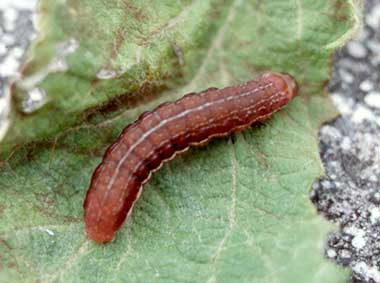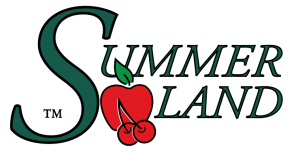Green Fruitworms
General Description
Hosts
Fruit trees (mainly apple and pear), many native trees including willow, birch, poplar and maple.
Damage
Buds - Small entry holes in buds, chewed petals and flower parts.
Leaves - Chewed young terminals.
Fruit - Wide irregular holes in small fruit (Fig. 1) resulting in large russeted scars and deep pits in mature fruit; feeding often distorts fruit.
.jpg) |
| Figure 1. Green fruitworm damage to apple. (BCMA) |
Identification
Larva - Yellowish-green to blue-green body with white to yellow longitudinal stripes and green to tan head (Figs. 2, 3); larvae may be speckled with small dark spots; mature larvae measure up to 35 mm long. Very young larvae will hang from silk threads when disturbed; older larvae curl up when disturbed and walk without a looping motion. There are two species of green fruitworms and one species of the less common brown fruitworm (Fig. 4).
.jpg)
|
 |
|
| Figure 2. Green fruitworm larva feeding on apple. (AA-FC) | Figure 3. Speckled green fruitworm larva. | Figure 4. Brown fruitworm larva. (H. Philip) |
Life History
Green fruitworms overwinter as adults, pupae or eggs, depending on species. Eggs hatch from just before bloom to after petal fall; larvae may be present from pink to 3-4 weeks after petal fall. Young larvae feed on flower parts and new leaves while older larvae feed mainly on developing fruit. When mature, larvae drop to the ground and burrow into the soil to pupate. Moths emerge in the fall or spring, depending on species. There is one generation per year.
Monitoring
Examine fruit bud and blossom clusters and terminal leaves for larvae in the spring. After blossoms open, use limb taps to determine the need for control.
Management
Biological Control
Bt products (Dipel 2X DF, Foray 48BA and Bioprotec CAF and Plus) are considered biological control products as their active ingredient ( a crystal toxic to caterpillars) is derived from naturally occurring Bacillus thuringiensis bacterium.
Chemical Control
Recommended products and timing for green fruitworm control in apple are:
-
Pink – Altacor,
-
Blossom – Dipel 2X DF, Foray 48BA, Bioprotec CAF or Bioprotec Plus
-
Petal fall – Altacor, Dipel, Foray, Cormoran or Bioprotec
Recommended products and timing for green fruitworm control in pear are:
-
Pink – Altacor
-
Blossom - Dipel, Foray or Bioprotec
-
Petal fall – Altacor, Dipel, Foray or Bioprotec
An application of a biological insecticide containing Bacillus thuringiensis (Dipel, Foray, or Bioprotec) during bloom or at petal-fall will control green fruitworms and leafrollers and is not toxic to bees or predatory insects and mites. Best spray timing varies with species present and weather conditions. See discussion of Bacillus thuringiensis products under Fruittree and European leafrollers below.
